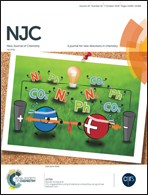A colorimetric paper sensor for visual detection of mercury ions constructed with dual-emission carbon dots†
Abstract
Fluorescent colorimetric test paper has broad prospects for the detection of different environments, medicines and foods by observing the variations of fluorescence brightness and color with the naked eye. Unlike classical pH test papers, however, it is usually limited in qualitative detection by fluorescence brightness and color, and colorimetry-based quantification remains a challenging task. Herein, a novel dual-colored carbon dot (CD) ratiometric fluorescent test paper has been developed for the semi-quantitative and visual assay of mercury ions (Hg2+) by a dose-sensitive color evolution. The blue fluorescence can be sensitively and selectively quenched by Hg2+, while the red fluorescence serves as the internal reference, inducing a distinguishable fluorescence color change from blue to red under illumination by a UV lamp and resulting in the ultrasensitive and visual detection of aqueous Hg2+. The detection limit of this highly sensitive ratiometric probe is as low as 0.14 nM. Moreover, a fluorescent test paper was constructed by printing “ink” onto a piece of filter paper with the probe solution, and a serial color evolution from blue to purple, pink and finally to red with the addition of Hg2+ was displayed, which provides a convenient and simple approach for the visual detection of Hg2+. Meanwhile, the as-prepared fluorescent colorimetric test paper was also successfully applied for the determination of Hg2+ in real water samples.



 Please wait while we load your content...
Please wait while we load your content...